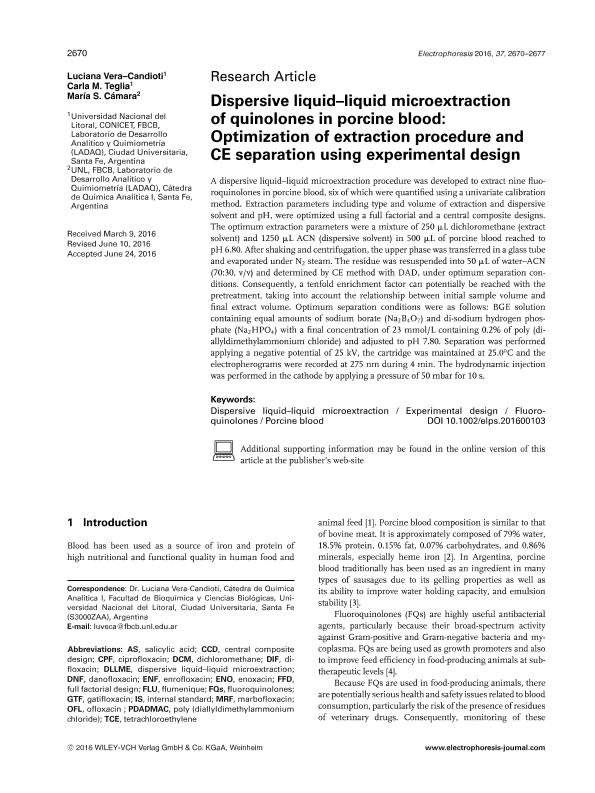Artículo
Dispersive liquid–liquid microextraction of quinolones in porcine blood: Optimization of extraction procedure and CE separation using experimental design
Fecha de publicación:
10/2016
Editorial:
Wiley VCH Verlag
Revista:
Electrophoresis
ISSN:
0173-0835
Idioma:
Inglés
Tipo de recurso:
Artículo publicado
Clasificación temática:
Resumen
A dispersive liquid–liquid microextraction procedure was developed to extract nine fluoroquinolones in porcine blood, six of which were quantified using a univariate calibration method. Extraction parameters including type and volume of extraction and dispersive solvent and pH, were optimized using a full factorial and a central composite designs. The optimum extraction parameters were a mixture of 250 μL dichloromethane (extract solvent) and 1250 μL ACN (dispersive solvent) in 500 μL of porcine blood reached to pH 6.80. After shaking and centrifugation, the upper phase was transferred in a glass tube and evaporated under N2 steam. The residue was resuspended into 50 μL of water–ACN (70:30, v/v) and determined by CE method with DAD, under optimum separation conditions. Consequently, a tenfold enrichment factor can potentially be reached with the pretreatment, taking into account the relationship between initial sample volume and final extract volume. Optimum separation conditions were as follows: BGE solution containing equal amounts of sodium borate (Na2B4O7) and di-sodium hydrogen phosphate (Na2HPO4) with a final concentration of 23 mmol/L containing 0.2% of poly (diallyldimethylammonium chloride) and adjusted to pH 7.80. Separation was performed applying a negative potential of 25 kV, the cartridge was maintained at 25.0°C and the electropherograms were recorded at 275 nm during 4 min. The hydrodynamic injection was performed in the cathode by applying a pressure of 50 mbar for 10 s.
Archivos asociados
Licencia
Identificadores
Colecciones
Articulos(CCT - SANTA FE)
Articulos de CTRO.CIENTIFICO TECNOL.CONICET - SANTA FE
Articulos de CTRO.CIENTIFICO TECNOL.CONICET - SANTA FE
Citación
Vera Candioti, Luciana; Teglia, Carla Mariela; Cámara, María Silvia; Dispersive liquid–liquid microextraction of quinolones in porcine blood: Optimization of extraction procedure and CE separation using experimental design; Wiley VCH Verlag; Electrophoresis; 37; 20; 10-2016; 2670-2677
Compartir
Altmétricas




